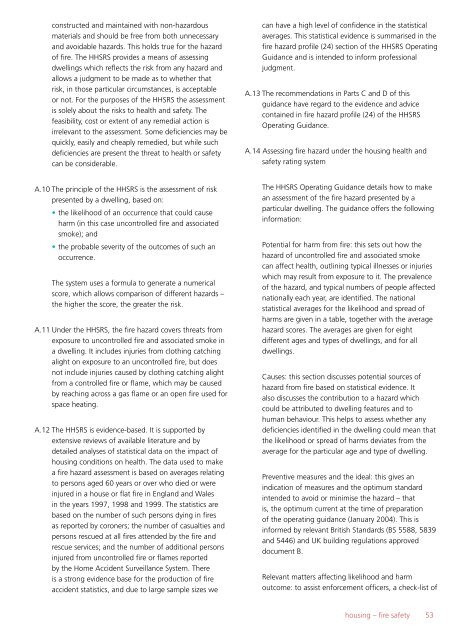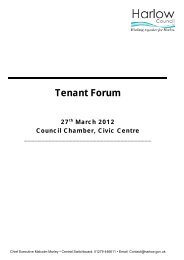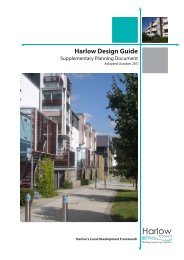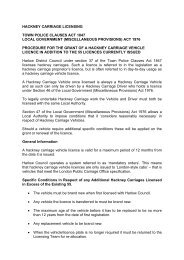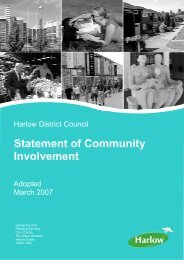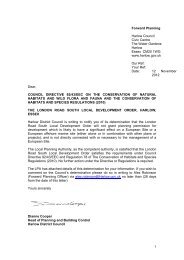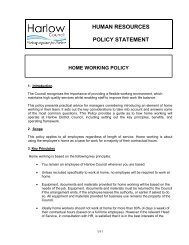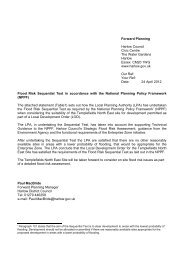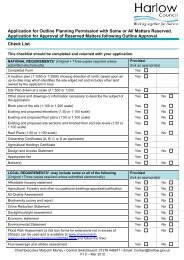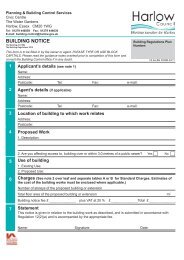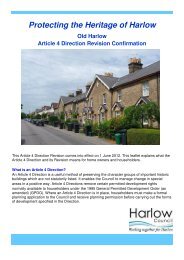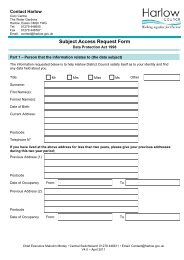HMO fire safety guidance - Harlow Council
HMO fire safety guidance - Harlow Council
HMO fire safety guidance - Harlow Council
You also want an ePaper? Increase the reach of your titles
YUMPU automatically turns print PDFs into web optimized ePapers that Google loves.
constructed and maintained with non-hazardous<br />
materials and should be free from both unnecessary<br />
and avoidable hazards. This holds true for the hazard<br />
of <strong>fire</strong>. The HHSRS provides a means of assessing<br />
dwellings which reflects the risk from any hazard and<br />
allows a judgment to be made as to whether that<br />
risk, in those particular circumstances, is acceptable<br />
or not. For the purposes of the HHSRS the assessment<br />
is solely about the risks to health and <strong>safety</strong>. The<br />
feasibility, cost or extent of any remedial action is<br />
irrelevant to the assessment. Some deficiencies may be<br />
quickly, easily and cheaply remedied, but while such<br />
deficiencies are present the threat to health or <strong>safety</strong><br />
can be considerable.<br />
can have a high level of confidence in the statistical<br />
averages. This statistical evidence is summarised in the<br />
<strong>fire</strong> hazard profile (24) section of the HHSRS Operating<br />
Guidance and is intended to inform professional<br />
judgment.<br />
A.13 The recommendations in Parts C and D of this<br />
<strong>guidance</strong> have regard to the evidence and advice<br />
contained in <strong>fire</strong> hazard profile (24) of the HHSRS<br />
Operating Guidance.<br />
A.14 Assessing <strong>fire</strong> hazard under the housing health and<br />
<strong>safety</strong> rating system<br />
A.10 The principle of the HHSRS is the assessment of risk<br />
presented by a dwelling, based on:<br />
• the likelihood of an occurrence that could cause<br />
harm (in this case uncontrolled <strong>fire</strong> and associated<br />
smoke); and<br />
• the probable severity of the outcomes of such an<br />
occurrence.<br />
The system uses a formula to generate a numerical<br />
score, which allows comparison of different hazards –<br />
the higher the score, the greater the risk.<br />
A.11 Under the HHSRS, the <strong>fire</strong> hazard covers threats from<br />
exposure to uncontrolled <strong>fire</strong> and associated smoke in<br />
a dwelling. It includes injuries from clothing catching<br />
alight on exposure to an uncontrolled <strong>fire</strong>, but does<br />
not include injuries caused by clothing catching alight<br />
from a controlled <strong>fire</strong> or flame, which may be caused<br />
by reaching across a gas flame or an open <strong>fire</strong> used for<br />
space heating.<br />
A.12 The HHSRS is evidence-based. It is supported by<br />
extensive reviews of available literature and by<br />
detailed analyses of statistical data on the impact of<br />
housing conditions on health. The data used to make<br />
a <strong>fire</strong> hazard assessment is based on averages relating<br />
to persons aged 60 years or over who died or were<br />
injured in a house or flat <strong>fire</strong> in England and Wales<br />
in the years 1997, 1998 and 1999. The statistics are<br />
based on the number of such persons dying in <strong>fire</strong>s<br />
as reported by coroners; the number of casualties and<br />
persons rescued at all <strong>fire</strong>s attended by the <strong>fire</strong> and<br />
rescue services; and the number of additional persons<br />
injured from uncontrolled <strong>fire</strong> or flames reported<br />
by the Home Accident Surveillance System. There<br />
is a strong evidence base for the production of <strong>fire</strong><br />
accident statistics, and due to large sample sizes we<br />
The HHSRS Operating Guidance details how to make<br />
an assessment of the <strong>fire</strong> hazard presented by a<br />
particular dwelling. The <strong>guidance</strong> offers the following<br />
information:<br />
Potential for harm from <strong>fire</strong>: this sets out how the<br />
hazard of uncontrolled <strong>fire</strong> and associated smoke<br />
can affect health, outlining typical illnesses or injuries<br />
which may result from exposure to it. The prevalence<br />
of the hazard, and typical numbers of people affected<br />
nationally each year, are identified. The national<br />
statistical averages for the likelihood and spread of<br />
harms are given in a table, together with the average<br />
hazard scores. The averages are given for eight<br />
different ages and types of dwellings, and for all<br />
dwellings.<br />
Causes: this section discusses potential sources of<br />
hazard from <strong>fire</strong> based on statistical evidence. It<br />
also discusses the contribution to a hazard which<br />
could be attributed to dwelling features and to<br />
human behaviour. This helps to assess whether any<br />
deficiencies identified in the dwelling could mean that<br />
the likelihood or spread of harms deviates from the<br />
average for the particular age and type of dwelling.<br />
Preventive measures and the ideal: this gives an<br />
indication of measures and the optimum standard<br />
intended to avoid or minimise the hazard – that<br />
is, the optimum current at the time of preparation<br />
of the operating <strong>guidance</strong> (January 2004). This is<br />
informed by relevant British Standards (BS 5588, 5839<br />
and 5446) and UK building regulations approved<br />
document B.<br />
Relevant matters affecting likelihood and harm<br />
outcome: to assist enforcement officers, a check-list of<br />
housing – <strong>fire</strong> <strong>safety</strong> 53


